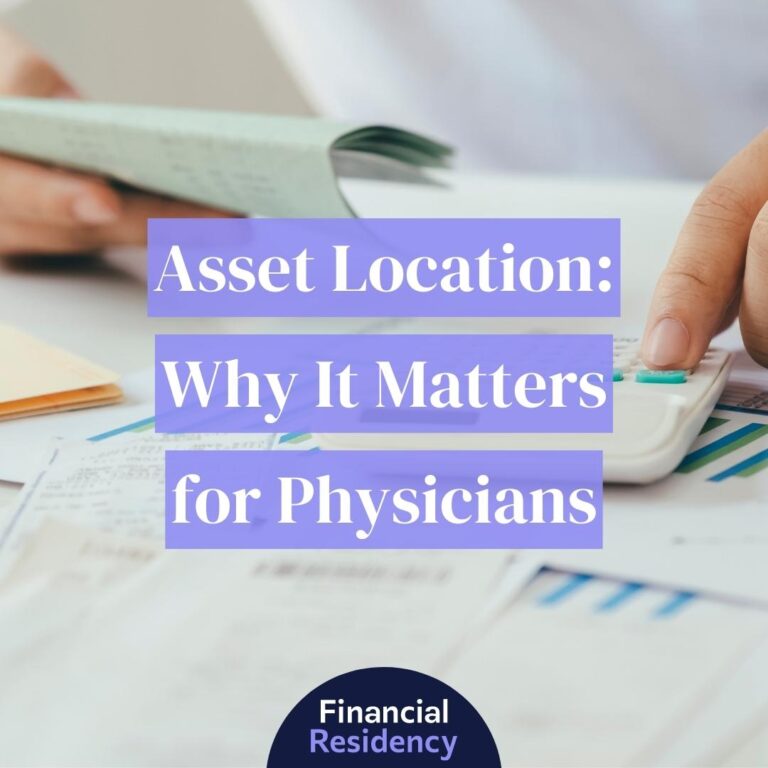As a physician, you might be wondering how to pay less in taxes, especially as you move up the ranks from a resident earning $60,000 to an attending earning hundreds of thousands of dollars.
Earning more is a good thing. It allows you to provide more for yourself and your family, give back to your community, and pursue your goals, whether that means buying a home, investing in real estate, paying off your debt, or taking a vacation.
However, with higher income comes higher taxes. That’s why it is important to know the best strategies to avoid paying high income taxes. Below, we’ll walk you through some tried and true ways to pay less income tax as a high-earning physician.
Tax Deductions vs. Credits
Before we start talking about the specific ways to pay less income tax, there is a distinction that you need to understand.
There are two main tax-reduction strategies:
- Through a deduction, or
- Through a tax credit
Let’s look at the key differences.
Tax Deductions for Physicians
A tax deduction is a reduction to your taxable income. When you contribute to your 401k, a traditional IRA, or take the student loan interest deduction, you are reducing your taxable income. These deductions reduce your tax owed by your marginal tax rate.
For example, let’s compare two single physicians making $100,000. If Physician 1 contributes $18,000 to her 401(k), she reduces her taxable income to $82,000.
If Physician 2 contributes $10,000 to his 401(k) he reduces his taxable income to $90,000. Since Physician 2 now has a higher taxable income, he is going to pay more taxes in the current year.
Tax Credits for Doctors
A tax credit differs from a tax deduction in that it reduces the actual amount of tax you owe (not your taxable income) dollar for dollar based on the amount of the tax credit.
Continuing off the previous example, let’s say both physicians have a kid who qualifies for the Child & Dependent Care Tax Credit and can take a $3,000 credit. This $3,000 directly reduces the tax owed.
Best Tax Strategies for Physicians
Now that you know the difference between a tax deduction and a tax credit, let’s discuss specific examples of how to pay less taxes as a physician.
1. Max Out Your Workplace Retirement Accounts
Your workplace likely offers some form of retirement account, whether it’s a 401(k), 403(b), 457(b), or SIMPLE IRA if you work for a small employer. You should max out whichever of these accounts are available to you to reduce your taxable income as much as possible.
In 2024, the maximum contribution limit for each plan is as follows:
- 401(k) Max Contribution – $23,000
- 403(b) Max Contribution – $23,000
- 457(b) Max Contribution – $23,000
- SIMPLE IRA – $16,000
There are a few things to note when it comes to maxing out your workplace retirement accounts.
You and your spouse can both max out your workplace retirement accounts in any given year. That means if you’re both working and both have a retirement plan available to you, then you can both max them out and reduce your taxable income significantly! That’s a quick, easy way to reduce the amount of tax you owe.
If you are age 50 or over, you can make an additional $7,500 contribution to your 401(k) or 403(b), or an additional $3,500 if your employer offers a SIMPLE IRA.
2. Take Advantage of the 457 Plan
If you work for an employer that offers a 457 plan, you are in an amazing position to pay less tax.
A 457 plan is a retirement plan established by state or local governments or by tax-exempt organizations under IRC 501(c). Most non-profit hospitals are set up under the IRC 501(c) designation, so if you work for one of these organizations, your employer may offer a 457 plan.
A 457 plan allows you to contribute up to $23,000 through pre-tax salary reductions in 2024. This amount is in addition to any contributions you make to your 401(k), 403(b), or SIMPLE IRA plan.
That means if you have access to a 401(k), 403(b), or SIMPLE IRA, and a 457 plan, you can double the amount of pre-tax contributions you make in any given year.
3. Max Out Your Individual Retirement Accounts
In addition to your workplace retirement plan, you can also open up an individual retirement account (IRA) to start saving money for your future and pay less tax in the current year. While this is a great way to reduce your tax bill even more, you need to be aware of income limits.
Traditional IRA
Contributing to a traditional IRA reduces your current year’s taxable income by the amount you contribute. In 2024, you can contribute up to $6,500 across your traditional and Roth IRAs ($7,500 if you’re 50 or older).
If you’re covered by a workplace retirement plan and your modified AGI is within or above certain limits, the amount you can contribute to a traditional IRA and deduct on your tax return will be limited.
Roth IRA
Like a traditional IRA, you can open a Roth IRA with companies like Vanguard and Fidelity and can direct your investments however you like. The contribution limit is also the same at $6,500 per year (or $7,500 if you’re 50 or older).
The difference with a Roth IRA is that contributing to it allows you to save money in the future, not today. When you contribute to a Roth IRA, you pay taxes on the dollars you put in now but never have to pay taxes on that money again, no matter how much it grows into the future.
So while you aren’t reducing your taxes in the current year, you will be earning many years of tax-free growth and have tax-free withdrawals once you reach age 59 ½. This is a great way to save your future self from taxes.
4. Contribute to Retirement Accounts as an Independent Contractor
If you’re an independent contractor or business owner, you likely won’t have access to a workplace 401(k), 403(b), or 457 plan. Here are a few options to reduce your taxes.
Solo 401(k)
Business owners, including independent contractors who have formed a business entity, can set up a solo 401(k) to make retirement contributions and lower their taxes.
This option is available to business owners who have no employees and covers both the employee-owner and his or her spouse. Since the business owner acts as the employee and the owner of the business, contributions to the solo 401(k) can be made in both capacities.
Through pre-tax salary reductions, as an employee of your own business, you can contribute up to $23,000 in 2024. Your business can then contribute additional funds to your solo 401(k). The total your business can contribute to your solo 401(k) is limited to 25% of your compensation.
The total amount that can be contributed to your solo 401(k) through employee salary reductions and contributions from your business is $69,000 in 2024. This can generate tons of tax savings for you if you own your own business.
Traditional or Roth IRA
The second way you can reduce your taxes as an independent contractor or business owner is to set up and contribute to a traditional or Roth IRA.
Since you aren’t covered by a workplace retirement plan (unless you set up a solo 401k, too), you can contribute up to the max into an IRA in any given year.
5. Deduct Expenses
Another way you can reduce your taxes as an independent contractor or business owner is to deduct as many legitimate business expenses as you possibly can. These expenses include work-related clothing (scrubs, white coat, shoes, etc.), licenses & fees, training materials, mileage, cell phone, computer, home office, and many other expenses.
These expenses are deducted from your income before you pay any income tax. It’s so important to use an expense tracking system to maximize the number of deductions you can take and reduce your taxable income.
Working with a CPA can also help you maximize your deductions since there could be deductions you aren’t aware of or ones that require more in-depth calculations.
6. Use a Health Savings Account (HSA)
Known for its triple tax savings, an HSA allows you to contribute pre-tax dollars, let that money grow tax-free, and then take a tax-free distribution as long as the distribution is used for qualifying medical expenses for you, your spouse, or your dependents. You’re eligible to contribute to an HSA if you’re enrolled in a high deductible health plan (HDHP) as defined by the IRS.
Contributions are limited based on whether you have self-only coverage or family coverage. If you take a distribution from your HSA that isn’t for a qualifying medical expense, you’ll owe income tax on the distribution as well as a tax penalty.
Once you reach age 65, you can take distributions from your HSA that aren’t for qualifying medical expenses and only pay income tax on the distributions without the additional 20% tax penalty.
This is a huge advantage of using an HSA. It essentially acts like a traditional IRA (pre-tax contributions, tax-free growth, and taxed distributions), but with an increased distribution age of 65. If you have access to an HSA, you should be using it.
7. Move to a State with No Income Tax
As of 2024, there are nine states that don’t levy personal income tax—Alaska, Florida, New Hampshire, Nevada, South Dakota, Tennessee, Texas, Washington, and Wyoming.
If you’re able to use geographic arbitrage to move to a state with no income tax, this could significantly reduce your tax bill each year, especially if you currently live in a state with high income taxes.
While no state income tax sounds great, just remember that having decreased income tax revenue likely means other taxes are levied in these states, and there might be reduced services and governmental support.
8. Own Real Estate
You shouldn’t own rental real estate just because it offers a tax break. However, if you have the time, money, and dedication to invest in real estate, it can give you positive cash flow and a paper loss on your tax return.
Just like owning a business, you can deduct expenses related to owning your rental property to offset the income you receive. These expenses include repairs, management fees, and general maintenance.
You can also deduct depreciation on your property every year. Residential rental properties are depreciated over their useful life which is defined as 27.5 years by the IRS. So, if you own a rental property with a cost basis of $100,000 for the structure and $50,000 for the land, you could deduct $3,636 ($100,000/27.5) a year as depreciation expense related to your property.
Bottom Line
There are plenty of ways to reduce your tax bill as a physician, now and in the future. Knowing how to pay less in taxes, especially as a high income earner, can help you decrease what is likely a major expense for you.
Using the strategies outlined above, you can decrease your tax bill, save more for retirement, and be on your way to achieving your financial goals.





